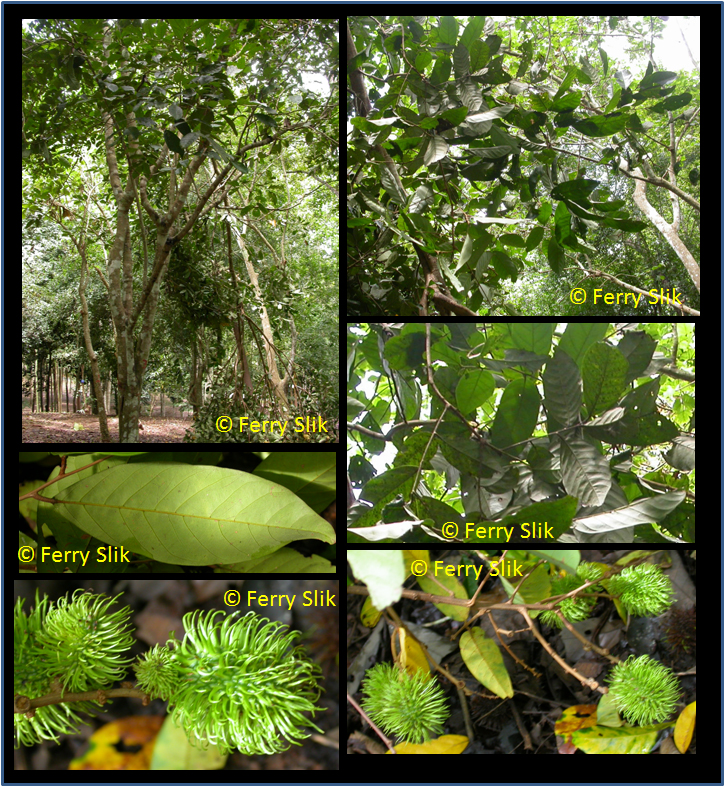Nephelium lappaceum L., Mant. Pl. 1 (1767)
Latin for 'bur', referring to the fruit appendages.Synonyms
Euphoria glabra Blume
Euphoria nephelium DC
Euphoria nephelium Poir.
Euphoria ramb-outan Labill.
Litchi ramboutan Labill.
Nephelium chryseum Blume
Nephelium glabrum Cambess.
Nephelium glabrum var. sufferrugineum (Radlk.) Ridl.
Nephelium glabrum Norona
Nephelium glabrum Reinw. ex Blume
Nephelium lappaceum var. glabrum Blume
Nephelium maculatum Radlk.
Nephelium mutabile var. pallens Hiern
Nephelium obovatum Ridl.
Nephelium pallens (Hiern) Radlk.
Nephelium rambutan Schnizl.
Nephelium sufferrugineum Radlk.
Nephelium xanthoides Radlk.
Description
Tree about 10-12 m tall; principal trunk is erect with an open crown of large branches; bark is slightly rugose, greyish or red.
Leaves are alternate, pinnately compound without an end-leaflet. On the lower surface of each leaflet are the domatia, small crater-like
hills located in the axils between the mid and secondary veins. The function of the domatia is unknown. Inflorescence pseudo-terminal to
usually terminal; flowers either male (only stamens well developed; trees dioecious) or hermaphrodite (trees monoecious), the latter either
effectively female (stamens small, anther not dehiscing) or male (stigma not opening), actinomorphic, whitish, yellowish or greenish;
sepals 4-5(7), nearly free to more than halfway connate, 0.7-2.1 mm long; petals usually absent, sometimes up to 4 reduced ones, not
exceeding 1.6 mm; disk complete, hairy or glabrous. Fruit an ellipsoid to subglobular schizocarp, up to 7 x 5 cm, weighing 20-95 g,
usually consisting of only 1 nutlet, yellowish to purplish-red, hardly stalked, often finally dehiscing (at least the apical part),
glabrous, usually densely set with filiform, curved, 0.5-2 cm long appendages; wall coriaceous, up to 2.5 mm thick. Seed covered by a
usually thick, juicy, white to yellow, translucent sarcotesta. The specific name stems from the Latin word ¡®lappaceus¡¯ meaning ¡®bur-like¡¯
and refers to the fruit appendages. The word rambutan is derived from the Malay word ¡®hair,¡¯ which describes the numerous, characterizing,
long, soft, red or red and green coloured spine-like protuberances (spinterns) on the surface of the fruit. [from www.worldagroforestry.org]
Ecology
In undisturbed to slightly disturbed (open sites) mixed dipterocarp, swamp
and sub-montane forests up to 1900 m altitude. Usually on alluvial sites and
hillsides with clay to sandy soils. In secondary forests usually present as a
pre-disturbance remnant, or planted.
Uses
Food: The trees are cultivated for their very popular fruit. The usually juicy sarcotesta around the seed is eaten.
The sweet-tasting fruits are consumed fresh, the more sour ones are eaten stewed. The sarcotesta can be canned or used in jam,
but loses much of its flavour. Seeds are edible when roasted, they are bitter and said to be narcotic. Edible tallow similar to
cacao butter, with a high level of arachidic acid, can be rendered from the seeds. The colourful fruits are frequently used in
displays with flower and fruit arrangements. Timber: The wood of N. lappaceum is liable to splitting during seasoning. It is
moderately hard to very hard, strong and tough. The wood is easy to work and can be finished well. It is durable under cover
and generally resistant to insect attacks, but susceptible to fungal attacks. The reddish coloured rambutan wood is usually too
small to be valued as timber. The average fibre length of wood is 1.07 mm. Tannin or dyestuff: Young shoots are used to produce
a green colour on silk that is first dyed yellow with turmeric. The fruit walls are used, together with tannin-rich parts of
other plants, to dye silk black after a preliminary red staining. Leaves are used, together with mud, as an impermanent black dye.
Lipids: Seeds contain an oil formerly used for illumination and a fat used formerly for soap. Wax: The seed kernel can be used for
the production of rambutan tallow, a solid fat similar to cacao butter, which is used for soap and candles. Poison: The fruit wall
contains a toxic saponin; cases of poisoning are known. Medicine: Fruit is said to be astringent, stomachic, and anthelmintic;
the leaves are used in poultices for headaches. In Java the toxic saponin is dried and used as medicine. In Malaysia, the roots are
used in a decoction for treating fever; and the bark as an astringent for tongue diseases.
Distribution
Southern China, Indo-China, Thailand, Peninsular Malaysia, Sumatra, Java,
Borneo (throughout the island), Philippines, Celebes.
Local names
Borneo: Buah beletti, Maritam, Rambutan, Rambutan hutan, Rangalau.
Cambodia: saaw maaw, ser mon.
Chinese: hooun mo daon shau tsz.
English: ramboostan, rambutan.
French: litchi chevelu.
German: Rambutan.
Indonesian: chorogol, gente, kakapas, rambutan.
Malay: buah abong, rambutan, rangalau.
Philippines: rambutan, usan.
Swahili: mshokishoki.
Thailand: ngoh, ngoh paa, phruan ngoh.
Vietnamese: ch[oo]m ch[oo]m, chom chom, saaw maaw, vai thi[ee][uf], vai thieu.
